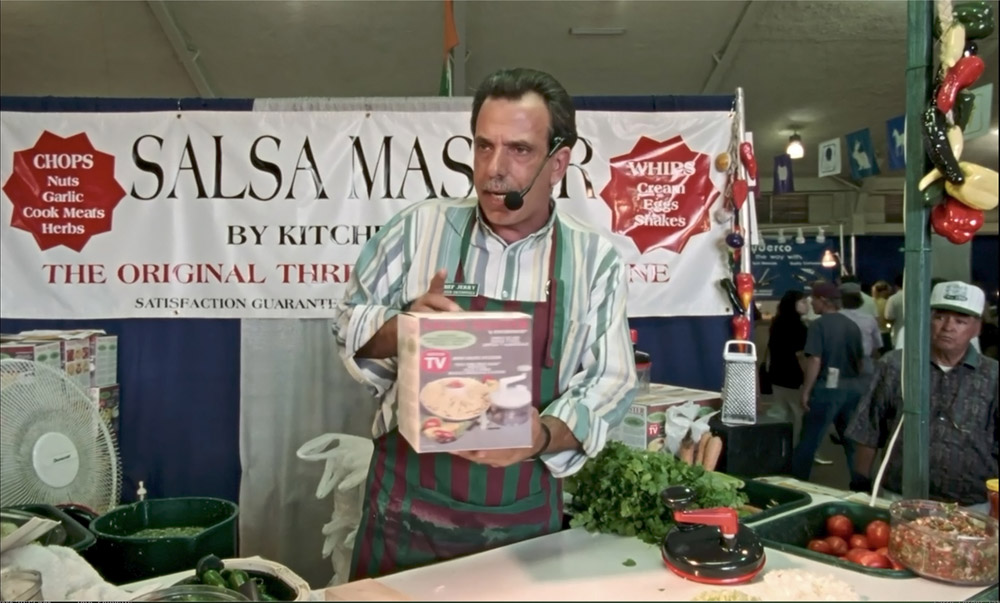When “Pitch People” first premiered at the Palm Beach Film Festival in 1999, it was capturing a zeitgeist moment when television was a predominant medium and those who got the most airtime were the hosts of ubiquitous informercials such as Nancy Nelson and Ron Popeil, filling in time slots that networks didn’t have other programming for to hawk kitchen gadgets and miracle cleaning wares. As much a late night presence as Letterman or Leno, director Stanley Jacobs wondered why there wasn’t more of a documented history of how such an industry began and when he would often work with crew that would be involved in producing such content, he set out to tell the story of these naturally charismatic characters and while the film had a successful festival run, issues with the film elements prevented any further play.
During the pandemic, Jacobs was drawn to revisit “Pitch People,” having few distractions from a proper restoration, and beyond the film looking brand new, there is a fresh sense of discovery about an entire epoch of American entrepreneurship that now seems to be a part of the past, though its legacy very much persists when “Shark Tank” remains a hit and you can still find longform ads running in between golf on Sundays and after midnight on cable. The late Ed McMahon recalls before sitting on the couch next to Johnny Carson, he learned how to be a good television personality when he was selling thousands of Morris Metric Slicers on the Atlantic City Boardwalk, making “$500 a week when milk was seven cents a bottle,” and the film dives into a fascinating chronicle of how these salesmen helped shape the burgeoning medium of television and how the business itself was shaped by two sides of the same family when Popeil, arguably the most famous pitchman of them all, was the great-nephew of Nathan Morris, the inventor of the Morris Metric Slicers whose own sons Arnold and Lester would become famous pitchmen in their own right, rivaling their cousin Ron at county fairs and eventually on TV.
With visits to the National Informercial Conference where demonstrations of the Salsa Master and the Wonder Scooper enthrall patrons and intriguing behind-the-scenes looks at how the ads are created, “Pitch People” is as charming as its subjects, who are selling themselves as much as any other product, are and lets them leap to the big screen, which is a better fit for the size of their personalities. On the eve of the film’s long-delayed general release in theaters, Jacobs spoke about restoring the film to its original glory, how he became interested in the world of pitch people in the first place and how a crew that worked in that world already enabled him to make the best film possible.
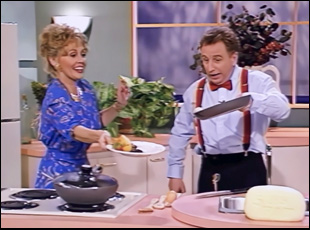
The pandemic hit in 2020 and I had a lot of equipment that was idle and people that I worked with didn’t have much to do. Back in 2000, there were no streaming services available and the film really didn’t have a proper distribution, so I thought there was an opportunity to resurrect the film and put it out there since it had never streamed and I always felt that it was a cultural document, of a part of advertising that hadn’t been captured, so that’s why I decided to dive in and get it prepared to get it out to the world again.
Of course, it brought back a lot of memories. I had worked with some of the people that appear in the film and it’s so strange because they’re locked in your mind the way they are in the film. Many have passed on now, but it was always wonderful to see them again and to hear them, and I was happy that they opened up so much when we did the film because there were a lot of things I wasn’t aware of during the three years when I had a crew following them around and capturing this. I wasn’t aware of the family rivalry that was happening between the Morrises and the Popeils, so it was neat to discover all that stuff while it was filmed and bringing it back out, it was somewhat nostalgic.
I also was happy with a lot of the way that the film moved. You’re worried nowadays because people feel the audience has a short attention span and you’re worried about people sticking with something. The film does stay with some of the interviewees because in my mind the way you get to know someone is really to let them speak and you see the little nuances of how they communicate with their facial expressions, so with some of them, I purposely leave on camera just so you can get to know them that way with time. I’m so happy that was a decision we made back then because you really get a sense of who these people are when you watch it.
How did you first get interested in this world?
I worked with a lot of these people doing long-form commercials, so that’s how I got to know them, and when I would talk with them, they had this whole history that I wasn’t even aware of, so I thought it’d be interesting to sit them down and get the history and then capture it at that time. I thought a documentary would be perfect for these guys because the Maysles brothers did “Salesman,” [about] Bible salesmen, and I’ve always loved that film, but no one had ever done a long-form about [this particular group of advertisers].
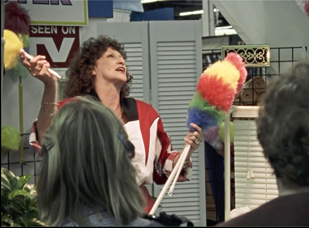
At the fairs, it was exciting because they’re all around you doing the different products and they are still in the fairs to this day — not as many, but there’s still a lot of them are still out there. It was quite fascinating to see everything and when we shot the film, what I told the crew was we shoot whatever happens. We were at the Eastern States Exposition in Massachusetts and I noticed a lady walked by and she had a broken sweeper that she bought, and I said, “What’s on with it?” And she said, “Well, it broke. I’m bringing it back.” So I said, “Would you mind if we film it?” So we wired her up and we filmed her bringing it back to the stand where she bought it from the year earlier and she was immediately given a new one, no questions asked.
It’s not in the film because there was no story there, but that was the approach I took and you see in the film some behind the scenes stuff [where] a couple of the guys are struggling with a product they couldn’t get to work by because they didn’t follow the instructions. Then there was another candid moment during the Super Chef demo where Arnold’s demonstrating the knives, and I wasn’t even present when that happened, but the crew just shot it and it was weeks later when I saw the dailies that I saw and I thought, “That’s wonderful.” It’s a nice piece of impromptu things that happened in these shoots.
The Salsa Master demo is such a showstopper and you let that play out in full. How did that decision come about?
One of the ideas I had was I definitely wanted to have a few, I call them concert pieces, where you actually would see the entire pitch, so people would get a sense of what it’s involved. We shot a lot of the pitches at the fairs and and his was one I thought was pretty dynamic. He had some nice phraseologies and double entendres, so I did him and Sandy’s duster pitch, and Al Spinell did the Shammy pitch. They all were like full, self-contained pitches that would give the audience a sense of what was going on because usually you just see bits and pieces, but there were these many concerts within the film.
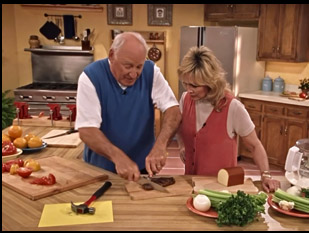
My approach was you just tell it as it is, present the facts. There’s a little bit of a rivalry between the brothers Lester and Arnold, even though they respect each other, so I thought just put the story out there in their words and I know people have heard the Popeil story all their lives because he’s such a dynamic individual and he made such an impact in selling products on TV, but they’re not aware of the other story, so it was good to have this other half that’s never been told because there is more to the story.
I tried to get Ron [Popeil] on camera, but they never responded to do an interview. and at the time that I did the film, Malcolm Gladwell actually contacted me, researching an article he was gonna do on Ron Popeil and he asked to see a copy of the film [which] I sent him. And he interviewed Lester and a few other pitch people, and eventually a piece came out in the Atlantic, a very nice and detailed piece, but it was mainly about Ron’s life and his history. There was some talk at that time that HBO was interested in doing a film about Ron’s life, and I think maybe in the back of Ron’s mind, maybe he thought it was better not to dilute his story. I don’t know, but he is represented in the film, but not in the way I would like to represent it.
You do get an interview with Ed McMahon, which now seems like a really crucial element. What was it like to speak to him?
It was great because Ed has such a solid background, coming from that industry and the reason why I got involved with that infomercial [shoot for the film] was because Ed was doing it, and when I had interviewed Arnold, he told me about how they worked with Ed back in Atlantic City, so I got involved with that infomercial so I could do the interviews with Ed, and he was very open to it and he was just one of those really classy guys. Again, the crew was able to capture a lot of that [impromptu] stuff while I wasn’t in the room because I had some really good film crews on the production and they were good about that, but it was a lot of fun.
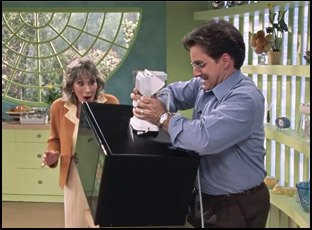
Originally, we were going to restore it from the 35 millimeter interpositive because the film was originally shot in Super 16, and then we bumped it up to 35 when it was done, and then an internegative was made, then an interpositive, and from that, you make the prints. I was going to restore it at the USC Film Archives, but when they put it up on their scanner, they found a bunch of white residue coming off the film, and it turns out that the white clear leader between that checkerboard – the AV rolls of the interpositive – had bleached onto the picture elements and kind of ruined them, so we thought “Okay, we had the internegative,” [which] was fine because I had black leader between the shots, not clear leader, and we also had the original Super 16A/B rolls and it turned out that the original Super 16 were better for resolution with digital tools available now, you could do a lot more with the color restoration. The downside of doing that is you have to retime the entire film.
We took a lot of time with it. One of the problems back in the late ‘90s was when we got footage from the archive houses, people were abandoning the original film elements, so a lot of it was on videotape, so I tried to find the original negative. That’s the thing with restoration. You want to always try to go back to the source and some of these places had lost track. It was impossible. So some were from film sources, but a lot of it was from video and when we had to up-res the video, we tried to be careful with it because there’s a lot of artifacts and things like that. We didn’t want to make it look too artificial and we took some care with that, but we didn’t want to overdo it because it is original archive stuff. But it’s never looked better than it looks now.
And it looks gorgeous projected. It’s going to be on March 1st at the Village East in New York City. It really looks like a beautiful film because it’s been restored to 4K – the original scans we did were 5K and we created a 4K master, and the reason for bringing it back to theaters is because really no one knows about it, so when it eventually goes to streaming and when people see the title later on, there’ll be some familiarity with it. There’s hundreds of titles and sometimes you don’t know where to begin, so maybe they’ll take a chance and take a look at it.
“Pitch People” will open on March 1st in New York at the Village East and on March 8th in Los Angeles at the Lumiere Cinema at the Music Hall.




